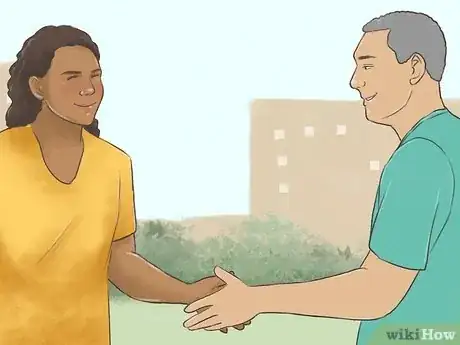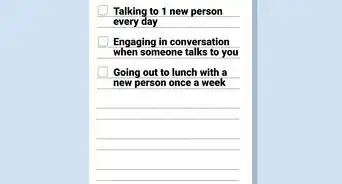This article was co-authored by Trudi Griffin, LPC, MS. Trudi Griffin is a Licensed Professional Counselor in Wisconsin specializing in Addictions and Mental Health. She provides therapy to people who struggle with addictions, mental health, and trauma in community health settings and private practice. She received her MS in Clinical Mental Health Counseling from Marquette University in 2011.
There are 14 references cited in this article, which can be found at the bottom of the page.
This article has been viewed 104,338 times.
Being an introvert can sometimes be a bit challenging, especially when you want to interact with others but have no idea how to. Introverts do not want to avoid friends or social interaction. Instead, they draw their strength from solitary activity, and find socializing more physically taxing. Being an introvert doesn't mean, though, that you can't or don't want to have friends.
Steps
Meeting New People
-
1Find common interest groups. Groups and events such as book clubs, cooking classes, or lectures can be good be places to meet people and find things that interest you. The attendees here are good people to talk to because you already know that you share at least one common interest. Most importantly, it gives you something to talk about when you meet someone, rather than try to make small talk, something many introverts do not enjoy.[1]
-
2Go to social events. New friends are very unlikely to just present themselves at your door, so you're going to need to find them. Social outings or places where there are other people to meet are a good way to start finding new friends. Look for social events and accept invitations; start saying "Yes!" even if it's hard or you feel more like staying at home.[2] [3]
- There are many organizations and groups out there for people looking to expand their social circle. It can be easier to talk to other people when you know they are there for the same reason you are.[4]
- If your workplace or friends are having a social event, offer to help. It will give you something to do at a party beyond trying to meet people. If a conversation seems to be running too long, you can always excuse yourself to deal with something party-related.[5] [6]
- If you have a hard time bringing yourself to go to social events, try giving yourself an informal quota. Give yourself space to do things socially, while also carving out time for yourself. That way you don't have to feel guilty about going to events, or for turning down invitations.[7]
Advertisement -
3Use welcoming body language. If you are out and about, and are willing to have people come and talk to you,[8] let them know they are welcome. Making your body open and large will make you more approachable to others.[9]
- Take up space where you are. Keep your head up, sit straight, or take long strides. This makes you appear confident, someone people will want to talk to.
- Uncross your arms. Crossed arms is a classic "don't talk to me" position. If your arms are open, you will appear more welcoming to people who might want to talk to you.
-
4Say hello to people. It's okay if this doesn't lead to a conversation; a simple greeting tells others that you are friendly. They may not always want to talk, but you've created someone who may want to talk more later.[10]
-
5Begin conversation by sharing something. Starting a conversation by telling the other person something about yourself can be a good ice-breaker. It does not have to be especially personal or particularly revealing. A simple statement like "I'm new here" or "It's my first time" lets the other person know you want to talk to them, and lets them know something about you.
-
6Ask open-ended questions. This gives people an opportunity to answer the question freely, and suggests you are open to learning more about them. Many people love the opportunity to talk about themselves and what they think, and may respond by asking you back.
- If you are attending an event, such as a lecture or a class, asking about the event is a good place to start. "What did you think of the talk?" can be effective, and it's an interest you already share.
- If you are talking to an acquaintance, that is someone you know, but not particularly well, a vaguer question like "How are you?" would be appropriate.[11]
- If you're talking to someone you've met before, try asking something personal, but not too personal, such as "What are some things you like to do on the weekend?" or "Do you have some favorite places around town?"
-
7Practice socializing. You want to improve your ability to interact with others. The only way to do that is the same way you improve any other skill: practice. You don't need to meet new people every day, but be willing to say hello and introduce yourself to people you don't know. Most conversations won't go anywhere, but that's fine. The goal is to get more comfortable in social settings for when you meet someone you do want to talk to.
- One way to help practicing is to copy the social skills of people you like or admire. Having an example to work off of can give you some clues about what to do in social settings. Get a more extroverted friend to be your "wingman."[12]
Making New Friends
-
1Be yourself. Focus on the things that interest you, and you'll be able to find people who share those interests. Common interests are a good basis for friendship.
- When talking to someone new, be careful about diving into controversial topics. There is nothing wrong with being interested in topics like politics or religion, but plunging right into them right away can put people off. This is unless, of course, you have joined a group of people with a common perspective on these issues.[13]
-
2Make contact. To make friends, you are going to need to put in a little effort. Call or text the other person, arrange to hang out somewhere outside of where you met. It's okay to be a little pushy. What seems like too much to you as an introvert might be just what the other person is looking for.[14]
- Making plans for later is a good way to stay in touch, especially if they are concrete. Even if it doesn't quite work out, it lets other people know you are open to meeting again, and may spur them on to other action.[15]
- Be specific when making plans. For example, rather than saying "We should hang out sometime," say "Would you like to see the new Spielberg movie next Saturday afternoon?" This makes it more likely that you'll follow through on your plans.
-
3Return messages. If someone reaches out to you to communicate, return the call. You can wait a little bit before you get back to them, but not returning the call or message is good way to push out those who want to be friends.[16]
- Refusing to communicate, through phone calls or other means, is not introversion. It could be shyness, or perhaps even depression, but those are not the same thing as introversion.[17]
-
4Use different forms of communication. Communicating doesn't have to mean phone calls. Introverts may not always enjoy speaking on the phone because context clues like body language are often missing, and there isn't as much control over the conversation. Text messaging, video chats, and even old-fashioned letter writing are all good ways to keep in touch. Just make sure you and the other person are in agreement about the best ways to communicate.[18]
-
5Be patient. Friendship is a process and takes some time. Allow for some early awkwardness, remembering that it will get easier if you push through it. Even if you aren't sure you're into it right away, fake it until you get past it.[19]
References
- ↑ https://www.psychologytoday.com/blog/the-introverts-corner/201202/survey-says-how-meet-new-people
- ↑ https://www.psychologytoday.com/blog/the-introverts-corner/201008/first-leave-the-house-strategies-making-new-friends
- ↑ http://www.entrepreneur.com/article/249372
- ↑ https://www.apartmenttherapy.com/10-tried-true-tips-how-to-make-new-friends-in-a-new-city-187285
- ↑ http://blogs.psychcentral.com/life-goals/2015/12/5-tips-for-introverts-at-bars-parties-and-social-events/
- ↑ https://www.psychologytoday.com/blog/the-introverts-corner/201512/the-perks-and-pleasures-hosting-party
- ↑ https://www.psychologytoday.com/blog/quiet-the-power-introverts/201103/socialize-or-not-is-the-question
- ↑ https://www.psychologytoday.com/blog/the-introverts-corner/201201/survey-says-introverts-dont-mind-being-chatted-sometimes
- ↑ http://www.huffingtonpost.com/vanessa-van-edwards/how-introverts-can-use-bo_b_4578260.html
- ↑ http://www.entrepreneur.com/article/249372
- ↑ http://www.entrepreneur.com/article/249372
- ↑ http://psychcentral.com/lib/the-benefits-of-being-an-introvert/?all=1
- ↑ https://www.psychologytoday.com/blog/the-introverts-corner/201102/mistakes-introverts-make
- ↑ https://www.psychologytoday.com/blog/the-introverts-corner/201008/first-leave-the-house-strategies-making-new-friends
- ↑ http://www.askmen.com/money/body_and_mind_150/194b_better_living.html
- ↑ https://www.psychologytoday.com/blog/the-introverts-corner/201102/mistakes-introverts-make
- ↑ https://www.psychologytoday.com/blog/the-introverts-corner/201503/is-introversion-interfering-your-friendships
- ↑ https://www.psychologytoday.com/blog/the-introverts-corner/201103/live-and-learn-and-adjust-rewriting-the-telephone-rules
- ↑ https://www.psychologytoday.com/blog/the-introverts-corner/201008/first-leave-the-house-strategies-making-new-friends
About This Article
Making friends as an introvert can be tough, since introverts tend to find it physically taxing to socialize with others. If you are willing to have people come and talk to you when you’re out and about, let them know they are welcome by using appropriate body language. For example, hold your head up and sit straight, as this will make you appear confident. Avoid crossing your arms, since it’s a classic “don’t talk to me” position. You can also make the first move and just say a friendly “hello” to someone. Even if it doesn’t lead to a conversation right away, they may want to talk later. During a conversation, ask people open-ended questions like, “What did you think of the lecture?” since it gives people a chance to talk about themselves. For more advice from our co-author, including how to set up plans with new friends, read on!







































































